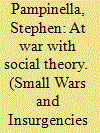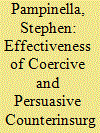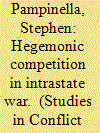| Srl | Item |
| 1 |
ID:
142605


|
|
|
|
|
| Summary/Abstract |
As US counterinsurgency campaigns draw to a close, doctrine for asymmetric warfare written during the War on Terror has come under heavy criticism. While many have argued that this shift to ‘winning hearts and minds’ is evidence that the United States is taking humanitarianism and nation-building seriously, others argue that a wide gap exists between US counterinsurgency doctrine and the protection of civilians afflicted by conflict. In this article, I show that the latter is true by comparing theories of instrumental and communicative action to US doctrine for operational design, stability operations, and counterinsurgency. I argue that these texts treat the people as an object to be manipulated for the achievement of pre-determined self-interested strategic goals rather than members of a community that jointly designs operations to fulfill shared objectives. However, US doctrine does contain communicative elements that, if prioritized, would better support humanitarian and state-building objectives otherwise subordinated in the War on Terror.
|
|
|
|
|
|
|
|
|
|
|
|
|
|
|
|
| 2 |
ID:
143543


|
|
|
|
|
| Summary/Abstract |
Which counterinsurgency approaches are most effective in defeating insurgencies? Counterinsurgency advocates and critics have debated the effectiveness of winning hearts and minds as well as using brute force against ordinary civilians. But little scholarship has sought to systemically compare these counterinsurgency approaches among a broad range of cases. This paper seeks to remedy this gap in the literature with an empirical analysis of 47 counterinsurgency wars from 1945–2000 to evaluate the effectiveness of coercive and persuasive approaches to counterinsurgency. To do so, I use crisp-set qualitative comparative analysis (QCA), or Boolean analysis, to identify the presence or absence of six coercive and persuasive counterinsurgency practices across all cases. This method enables me to highlight how counterinsurgency victory can be produced by combinations of practices rather than a single set of practices that might be expected to be useful across cases. The results demonstrate that many combinations of coercive, persuasive, and mixed counterinsurgency practices can lead to victory. However, more persuasive combinations of practices consistently lead to counterinsurgent victory compared to others, although limited coercion against civilians is constant in all cases of counterinsurgency. These findings cast doubt on the ability of counterinsurgents to refrain from harming civilians and suggest that victory requires a mix of both positive and negative incentives for cooperation.
|
|
|
|
|
|
|
|
|
|
|
|
|
|
|
|
| 3 |
ID:
110001


|
|
|
|
|
| Publication |
2012.
|
| Summary/Abstract |
This article employs social constructivist approaches drawn from social movement theory and international relations to explain outcomes of insurgency and counterinsurgency. It argues that mobilizing civilians requires the formation of hegemonic social relations that legitimate coercive force in defense of the political community. Four social mechanisms are hypothesized to be relevant in the creation of hegemony: brokerage, diffusion, reflexive self-restraint, and self-fulfilling prophecies. This constructivist theory of hegemonic competition is then evaluated using a case study of insurgency and counterinsurgency in Iraq's al-Anbar province.
|
|
|
|
|
|
|
|
|
|
|
|
|
|
|
|